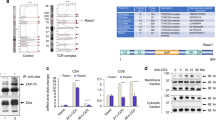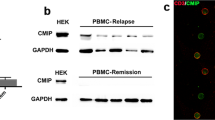Abstract
In order to generate coherent biological responses to extracellular stimuli, cells have established synergistic and antagonistic crosstalk between pathways with similar or opposing functions, respectively. Two routes cooperating in the generation of mitogenic and cytoskeletal functions are those induced by Ras and Rho/Rac GTPases. In these signaling interactions, Rho/Rac proteins have been always placed in a downstream position respect to Ras in all cell systems analysed so far. In this report, we describe that such signaling hierarchy does not apply to T-lymphocytes. Thus, we show that both Rac1 GDP/GTP exchange factors such as Vav and constitutively active versions of Rac1 can promote the effective stimulation of the Ras pathway in T-lymphocytes. The molecular link for this new type of pathway interconnectivity is RasGRP1, a diacylglycerol-dependent GDP/GTP exchange factor for Ras that translocates to the plasma membrane in a Vav- and Rac1-dependent manner. The effect of the Vav/Rac1 pathway on the Ras pathway is highly dependent on the activity of phospholipase C-γ, the key cellular supplier of intracellular diacylglycerol. Signaling experiments suggest that this crosstalk represents a signaling strategy used by the T-cell receptor to promote robust biological responses of both the Rac/Rho and Ras pathways upon antigen engagement.
This is a preview of subscription content, access via your institution
Access options
Subscribe to this journal
Receive 50 print issues and online access
$259.00 per year
only $5.18 per issue
Buy this article
- Purchase on Springer Link
- Instant access to full article PDF
Prices may be subject to local taxes which are calculated during checkout






Similar content being viewed by others
References
Bar-Sagi D and Hall A . (2000). Cell, 103, 227–238.
Bivona TG, Perez De Castro I, Ahearn IM, Grana TM, Chiu VK, Lockyer PJ, Cullen PJ, Pellicer A, Cox AD and Philips MR . (2003). Nature, 424, 694–698.
Boettner B and Van Aelst L . (2002). Gene, 286, 155–174.
Bustelo XR . (2000). Mol. Cell. Biol., 20, 1461–1477.
Bustelo XR . (2002a). Histol. Histopathol., 17, 871–875.
Bustelo XR . (2002b). BioEssays, 24, 602–612.
Caloca MJ, Zugaza JL and Bustelo XR . (2003a). J. Biol. Chem, 278, 33465–33473.
Caloca MJ, Zugaza JL, Matallanas D, Crespo P and Bustelo XR . (2003b). EMBO J., 22, 3326–3336.
Cantrell DA . (2003). Immunol. Rev., 192, 122–130.
Costello PS, Walters AE, Mee PJ, Turner M, Reynolds LF, Prisco A, Sarner N, Zamoyska R and Tybulewicz VL . (1999). Proc. Natl. Acad. Sci. USA, 96, 3035–3040.
Crespo P, Bustelo XR, Aaronson DS, Coso OA, Lopez-Barahona M, Barbacid M and Gutkind JS . (1996). Oncogene, 13, 455–460.
Diaz-Flores E, Siliceo M, Martinez AC and Merida I . (2003). J. Biol. Chem., 278, 29208–29215.
Dower NA, Stang SL, Bottorff DA, Ebinu JO, Dickie P, Ostergaard HL and Stone JC . (2000). Nat. Immunol., 1, 317–321.
Ebinu JO, Bottorff DA, Chan EY, Stang SL, Dunn RJ and Stone JC . (1998). Science, 280, 1082–1086.
Ebinu JO, Stang SL, Teixeira C, Bottorff DA, Hooton J, Blumberg PM, Barry M, Bleakley RC, Ostergaard HL and Stone JC . (2000). Blood, 95, 3199–3203.
Etienne-Manneville S and Hall A . (2002). Nature, 420, 629–635.
Fujikawa K, Miletic AV, Alt FW, Faccio R, Brown T, Hoog J, Fredericks J, Nishi S, Mildiner S, Moores SL, Brugge J, Rosen FS and Swat W . (2003). J. Exp. Med., 198, 1595–1608.
Hogquist K . (2001). Trends Immunol., 22, 69.
Inabe K, Ishiai M, Scharenberg AM, Freshney N, Downward J and Kurosaki T . (2002). J. Exp. Med., 195, 189–200.
Joneson T and Bar-Sagi D . (1998). J. Biol. Chem., 273, 17991–17994.
Joneson T, McDonough M, Bar-Sagi D and Van Aelst L . (1996). Science, 274, 1374–1376.
Kim HK, Kim JW, Zilberstein A, Margolis B, Kim JG, Schlessinger J and Rhee SG . (1991). Cell, 65, 435–441.
Kranewitter WJ and Gimona M . (1999). FEBS Lett., 455, 123–129.
Lambert JM, Lambert QT, Reuther GW, Malliri A, Siderovski DP, Sondek J, Collard JG and Der CJ . (2002). Nat. Cell Biol., 4, 621–625.
Layer K, Lin G, Nencioni A, Hu W, Schmucker A, Antov AN, Li X, Takamatsu S, Chevassut T, Dower NA, Stang SL, Beier D, Buhlmann J, Bronson RT, Elkon KB, Stone JC, Van Parijs L and Lim B . (2003). Immunity, 19, 243–255.
Lopez-Lago M, Lee H, Cruz C, Movilla N and Bustelo XR . (2000). Mol. Cell. Biol., 20, 1678–1691.
Lorenzo PS, Beheshti M, Pettit GR, Stone JC and Blumberg PM . (2000). Mol. Pharmacol., 57, 840–846.
Lowy DR and Willumsen BM . (1993). Annu. Rev. Biochem., 62, 851–891.
Matthews SA, Rozengurt E and Cantrell D . (2000). J. Exp. Med., 191, 2075–2082.
Ohtsuka T, Kaziro Y and Satoh T . (1996). Biochim. Biophys. Acta, 1310, 223–232.
Overbeck AF, Brtva TR, Cox AD, Graham SM, Huff SY, Khosravi-Far R, Quilliam LA, Solski PA and Der CJ . (1995). Mol. Reprod. Dev., 42, 468–476.
Powis G, Bonjouklian R, Berggren MM, Gallegos A, Abraham R, Ashendel C, Zalkow L, Matter WF, Dodge J and Grindey G . (1994). Cancer Res., 54, 2419–2423.
Priatel JJ, Teh SJ, Dower NA, Stone JC and Teh HS . (2002). Immunity, 17, 617–627.
Pronk GJ and Bos JL . (1994). Biochim. Biophys. Acta, 1198, 131–147.
Reynolds LF, Smyth LA, Norton T, Freshney N, Downward J, Kioussis D and Tybulewicz VL . (2002). J. Exp. Med., 195, 1103–1114.
Shan X, Czar MJ, Bunnell SC, Liu P, Liu Y, Schwartzberg PL and Wange RL . (2000). Mol. Cell. Biol., 20, 6945–6957.
Teixeira C, Stang SL, Zheng Y, Beswick NS and Stone JC . (2003). Blood, 102, 1414–1420.
Toullec D, Pianetti P, Coste H, Bellevergue P, Grand-Perret T, Ajakane M, Baudet V, Boissin P, Boursier E, Loriolle F, Duhamel L, Charon D and Kirilovsky J . (1991). J. Biol. Chem., 266, 15771–15781.
Turner M and Billadeau DD . (2002). Nat. Rev. Immunol., 2, 476–486.
Vassilopoulos D, Smallridge RC and Tsokos GC . (1995). Clin. Immunol. Immunopathol., 77, 59–68.
Villalba M, Bi K, Hu J, Altman Y, Bushway P, Reits E, Neefjes J, Baier G, Abraham RT and Altman A . (2002). J. Cell Biol., 157, 253–263.
Villalba M, Coudronniere N, Deckert M, Teixeiro E, Mas P and Altman A . (2000a). Immunity, 12, 151–160.
Villalba M, Hernandez J, Deckert M, Tanaka Y and Altman A . (2000b). Eur. J. Immunol., 30, 1587–1596.
Wang XJ, Liao HJ, Chattopadhyay A and Carpenter G . (2001). Exp. Cell Res., 267, 28–36.
Wu J, Katzav S and Weiss A . (1995). Mol. Cell. Biol., 15, 4337–4346.
Yu H, Leitenberg D, Li B and Flavell RA . (2001). J. Exp. Med., 194, 915–926.
Zheng Y . (2001). Trends Biochem. Sci., 26, 724–732.
Zuber J, Tchernitsa OI, Hinzmann B, Schmitz AC, Grips M, Hellriegel M, Sers C, Rosenthal A and Schafer R . (2000). Nat. Genet., 24, 144–152.
Acknowledgements
We thank M Blázquez for technical assistance. This work was supported by the US National Cancer Institute (CA7373501), the Programa General del Conocimiento of the Spanish Ministry of Science and Technology (PM99-0093), and a grant from the Ministry of Education and Culture of the Autonomous Government of Castilla-León (SA051/02). MJC and JLZ are investigators of the Ramón y Cajal Program (Spanish Ministry of Science and Technology) associated to the University of Salamanca. The Centro de Investigación del Cáncer is supported by endowments from the CSIC, University of Salamanca, Castilla-León Autonomous Government, the Spanish National Network of Cancer Centers (Carlos III Institute, Spanish Ministry of Health), the Foundation for Cancer Research of Salamanca (FICUS), and the Solórzano and Moraza Foundations.
Author information
Authors and Affiliations
Corresponding author
Rights and permissions
About this article
Cite this article
Zugaza, J., Caloca, M. & Bustelo, X. Inverted signaling hierarchy between RAS and RAC in T-lymphocytes. Oncogene 23, 5823–5833 (2004). https://doi.org/10.1038/sj.onc.1207768
Received:
Revised:
Accepted:
Published:
Issue Date:
DOI: https://doi.org/10.1038/sj.onc.1207768
Keywords
This article is cited by
-
ROCK1 is a novel Rac1 effector to regulate tubular endocytic membrane formation during clathrin-independent endocytosis
Scientific Reports (2017)
-
The Role of Rho/Rho-Kinase Pathway in the Expression of ICAM-1 by Linoleic Acid in Human Aortic Endothelial Cells
Inflammation (2012)
-
Vav1
AfCS-Nature Molecule Pages (2010)
-
Vav2
AfCS-Nature Molecule Pages (2008)
-
Phospholipase Cγ/diacylglycerol-dependent activation of β2-chimaerin restricts EGF-induced Rac signaling
The EMBO Journal (2006)



